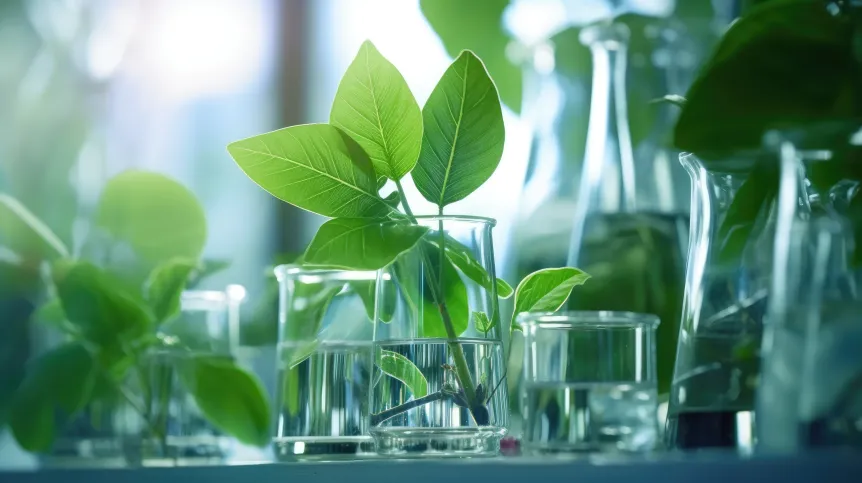
Scientists from the Wrocław Medical University are investigating the mechanism of production of toxic substances by plants. The results may be used to produce drugs. The research project is carried out with the Free University of Berlin.
Plants produce chemical substances that help them effectively defend themselves against harmful environmental influences. The mechanism of this production remains unknown. What causes the plant to produce toxic proteins and saponins, what their proportions depend on and how exactly this double deadly system works - these are the questions that the research carried out at the Department of Biology and Pharmaceutical Biotechnology of the Wrocław Medical University aims to answer.
According to the information on the website of the Wrocław Medical University, the project is 'Regulation of a plant based synergistic toxicity between triterpene saponins and ribosome-inactivating proteins' is financed by the National Science Center in the amount of nearly one million PLN.
It is carried out by the team led by Professor Adam Matkowski, head of the Department of Biology and Pharmaceutical Biotechnology at the Wrocław Medical University. The research is planned for three years. It is part of an international research project conducted jointly with the Department of Pharmaceutical Biology of the Freie Universität Berlin, headed by Professor Alexander Weng. The Wrocław part is purely experimental. The research results of scientists from the Wrocław Medical University will be used by the German centre as a basis for testing potential therapeutic effects.
'Plants threatened by attacks by other organisms cannot escape or change their location when they find themselves in unfavourable environmental conditions. Therefore, they must defend themselves passively. They can protect themselves against herbivores, parasites or pathogenic microorganisms with physical barriers: thorns, thickened bark, cuticle, resins, etc. However, the most intelligent weapons, developed over thousands of years of co-evolution, are plant chemicals that make the plant body (or parts of it) poisonous, tasteless, indigestible or repulsive,’ says Professor Adam Matkowski.
He adds that medicinal plants have been selected by humans from nature as they have a stronger physiological effect on the body than others. They often produce sophisticated mixtures of substances that act on various mechanisms in other organisms.
This time, the Wrocław Medical University scientists are investigating two common plants: Gypsophila elegans (the annual baby's-breath - known, for example, as an addition to bouquets) and Agrostemma githago (the common corn-cockle, once a common weed, today an endangered plant, but also an ornamental one). Both belong to the carnation family, which is unique in the plant world in terms of chemical defence.
'The deadly mixtures produced by carnation contain, on the one hand, small-molecule substances called saponins (natural detergents), and on the other hand, rare and specific toxic proteins called ribosome-inactivating proteins (RIP), capable of killing cells of other organisms by damaging the protein production machinery. They are capable of killing any cell,’ we read in the Wrocław Medical University press release.
Saponins include thousands of very diverse and at the same time structurally similar substances. They are produced by many groups of plants. In pharmacy, saponins are used as expectorants and as adjuvants, e.g. in vaccines. However, in tandem with RIPs, they have been discovered in large quantities only in the carnation family.
'By acting synergistically with RIPs, saponins create the so-called toxic two-component system (TTS). This +cooperation+ enhances the toxic effect of RIPs towards herbivorous animals and probably also microorganisms. It is a specialised defensive weapon of plants related to carnations, which may also play a role in their medicinal properties - according to the principle that poisons can also heal. However, we know very little about the coordination of the production of these two TTS components in a living plant. We do not know what causes these proteins to appear in the plant in certain proportions. We chose two interesting plants for research: the annual baby's-breath, which is easy to grow and contains large amounts of well-known saponins and RIPs, and the less known common corn-cockle, in which a new type of RIP proteins was recently discovered,’ Matkowski explains.
The project under the acronym RIP-SAPO assumes the use of biotechnological methods. The researchers will focus on accurate profiling of proteins and gene expression, and identification of those substances that are most responsible for the specific properties of plants. Plants and their parts must be grown in the laboratory under strict control of environmental conditions. This is necessary to limit the impact of uncontrollable factors, which would be impossible to avoid in nature.
At the same time, various substances that have a stimulating effect on plant cells will be administered to the cultured cells. These may, for example, be inactivated fragments of cell walls of bacteria and fungi, as well as signalling molecules used by plant cells to alert the body to the attack of pathogens (e.g. salicylic acid, nitric oxide or hydrogen peroxide). All this to verify the hypotheses about the expected increase or change in the composition of TTS components.
Scientists want to test the impact of these factors both on cells growing freely in media and on cultured plant organs: roots and shoots. On this basis, a laboratory culture system will be developed, in which it will be possible to direct the production of selected ingredients under the influence of specific factors.
'In this way, we will find out what external factors cause the plant to develop complex mixtures of defence substances. This will also be important for the development of improved therapies, as well as for improving the natural immunity of crop plants,’ says Professor Matkowski.(PAP)
PAP - Science in Poland, Roman Skiba
ros/ zan/ kap/
tr. RL













